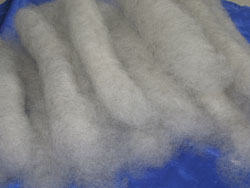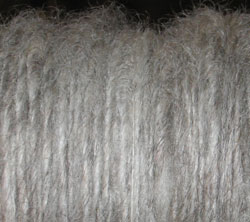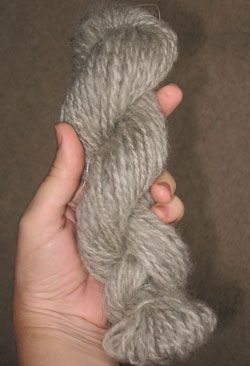Videos
Return to
Articles
page

Spinning Woollen
The Story of Longdraw Drafting
Woollen yarns, with their distinctive tangly-spiral structure, are lofty, warm, airy, snuggly, and soft. Though not as hard-wearing as their worsted cousins, these yarns are excellent for winter scarves, hats and sweaters, and they're the perfect choice for "felted knits".
True woollens are spun with the longdraw drafting technique, a highly efficient (and comfortable!) way of spinning. To spin a true woollen, you need to start with carded wool rolags. These humble rolls of wool make the job easy: they are predisposed to making woollen yarn, as fibre in the rolags comes off the end in a spiral as you draft it.
The longdraw technique has fallen into disuse by modern handspinners because many of us use commercially prepared fibres -- which are gratifyingly ready whenever we want them (and often heart-meltingly beautiful), but are not suited for spinning a true woollen.
There's a reading list at the end of this page -- scroll down to see it. ...And happy viewing! :-)

The woollen structure is distinctive (click on the image for a closer view), and that structure gives the yarn its excellent airiness and warmth. These yarns have a beauty of their own; and the longdraw drafting technique is not at all complicated.
The vocabulary of woollen spinning (like the vocabulary of any technique) can be confusing. It's worth mentioning a couple of terms here, because they pop up from time to time and are often used incorrectly.
♦ Supported longdraw refers to longdraw drafting in which the hand closest to the wheel helps the drafting hand by blocking twist from time to time. Supported longdraw is helpful, and especially so when the fibres are slippery, or if the rolags are uneven.
♦ Unsupported longdraw refers to longdraw drafting which uses only one hand. Unsupported longdraw is used in many places, but is most well-known as the drafting method used to spin woollen yarns on a great wheel: one hand does all the fibre control and drafting while the other hand runs the wheel.
Both techniques are useful; neither is "better" than the other; and both appear in the video.
And what makes longdraw drafting really "longdraw"? ...It has little to do with how far you move your arm before you wind the yarn onto the bobbin, though that's the part most easily seen.
In longdraw drafting, you rapidly draw out a length of underspun yarn, then attenuate that length as the twist flows into it. Attenuation is the sliding, stretching, firming-up action that happens during the "pause" at the far end of the drafting movement. ...To put it concisely: longdraw is "long" because the length of underspun yarn is the drafting zone! (That puts a whole different spin on things, doesn't it?)
If you've never tried proper longdraw spinning, give it a whirl! It's fast, comfortable, and liberating -- and sometimes just plain refreshing. :-)

Suggested Reading
Few spinning books really cover woollen spinning in detail; most contain just a quick overview of the technique. Here are some good starting points:
♦ Fournier, Nola and Jane. In Sheep's Clothing. The thorough and thoughtful information on wool is followed by excellent carding instructions.
♦ Baines, Patricia. Spinning Wheels, Spinners and Spinning. Clear instructions on both carding and longdraw technique.
♦ Ross, Mabel. The Encyclopedia of Handspinning. Sadly out of print; but it contains an excellent, concise description of longdraw.
♦ Ross, Mabel. The Essentials of Handspinning. Brief instructions for longdraw drafting appear in the back.
♦ Davenport, Elsie. Your Handspinning. Dated, but still useful. The longdraw instructions are accurate but a little hard to follow.